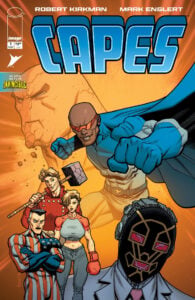In this week’s abbreviated Wednesday Comics Reviews, the team reviews the new remastered version of Capes #1, as well as Ibrahim Moustafa and Matt Kindt’s new expansion of John le Carré’s world into comics! Plus, The Prog Report!
 Capes #1
Capes #1
Writer/Letterer: Robert Kirkman
Artist: Mark Englert
Publisher: Image Comics – Skybound
Review by Khalid Johnson
Writer Robert Kirkman, and artist/series co-creator Mark Englert revisit and remaster the 20-year-old series Capes following Invincible Season 3’s introduction of characters from the series. Looking at the original release, there is a new level of polish from Englert that as an artist should be celebrated. Being able to go back and incorporate the things learned, the confidence in anatomy and environment, it’s all reflected and I think that’s beautiful.
Looking at it on a story level, playing in the world of Invincible they build out that world with Capes, a failing corporate superhero business where heroes do their superhero-ing like a 9-5, you clock in, you clock out, there’s a day shift, there’s a night shift. For my personal taste, I am not a lover of the corporate superhero and the last page is the perfect example of why summed up neatly in a couple of panels.
Some of the moments here felt like they rhymed with the less edgy parts of The Boys though much less mean-spirited in the exploration and with much less contempt for superheroes as a concept. We are introduced to an assortment of superheroes all on the job, namely Bolt, Commander Capitalism and Kid Thor and the blending of the superhero with the trappings of corporate life keep things light as we move around, right up until the precursor to some brand new crisis appears.
My personal feelings on corporate superheroes aside, this book feels accessible, and it takes its time building out the character dynamics through conversation and some meta textual stuff that lets the characters breathe in a world that has been so full of life.
 John le Carré’s: The Circus — Losing Control #1
John le Carré’s: The Circus — Losing Control #1
Writer: Matt Kindt
Art: Ibrahim Moustafa
Colors: Brad Simpson
Letters: Simon Bowland
Publisher: Dark Horse Comics
Review by Clyde Hall
If you’re even passingly familiar with the work of John le Carré (Tinker Tailor Soldier Spy, The Spy Who Came In From The Cold, The Night Manager), it’s easy to understand Ian Fleming’s James Bond adventures. Such espionage tales with one foot in operatic global threat mythology and the other in actual spy business was one way of working through the aftermath of Fleming’s time in WWII British naval intelligence. Because real espionage is a dirty business. One that can lobotomize human decency in those performing spy-craft services.
John le Carré, MI5 and MI6 Cold War veteran that he was, understood this implicitly. It was foundational for his George Smiley espionage novels. And it continued being the basis of his fiction as le Carré wrote about the shifting espionage climate that emerged following the fall of the U.S.S.R. He was a master craftsman in making the hopes, failures, humor, violence, and vendettas of spies relatable to readers.
When you put le Carré’s name on a title chronicling further stories of his Circus as the center of the British Secret Service, you have a lot of reputation to live up to. Get it wrong, and you might end up logging in a facts-light film about real life assets that real life people including Ian Fleming knew. Creating an enjoyable action film like The Ministry of Ungentlemanly Warfare, but without delving into the fate of those actual undercover wartime operatives following the events in the movie.
When you get the tradecraft elements and stories à la le Carré right, however, it looks like John le Carré’s: The Circus — Losing Control. In this book, Ibrahim Moustafa’s paneling and artwork at first seems muted, like the everyday pace of any office worker’s typical morning. Until, that is, Moustafa pulls back the curtain ever so slightly to show you what Maggie’s inner dialogue is working through. It’s a brilliant visually rendering of the spy mindset that, if you’re not making the process look mundane and normal, you’re working your assets wrong.
Matt Kindt, meanwhile, scripts an opening chessboard setup for the characters, center stage and peripheral, and for the Circus as an operational entity. Sounds pretty stiff, right? Not the way he goes about it, which includes flashbacks of violent clashes and skullduggery forging the characters involved into the operatives they are when our story commences.
The Circus oversees and protects Britain’s most sensitive secrets. Calling the shots is a master spy codenamed Control. He has final say on which agent gets a mission, which assets are irreplaceable, and which pawns get sacrificed. He’s essential to overall operational success, fingers in uncalculated numbers of Eyes-Only pies, and with the litany of rivals to prove it – both foreign and domestic. If Control went missing, the Circus could fold. The enemies of the state would take bold advantage. Confidence wouldn’t just be high, it would go orbital.
That’s why, when Control does go missing, it’s naturally kept a secret. Even from the rest of the Circus. Kept secret by the one agent with a scope of understanding that rivals Control’s where the espionage organization is concerned: His Mother. Mothers are assistants, agents in charge of keeping the men and women in charge briefed, scheduled, and updated. Maggie Salinger is the Mother in question, and it’s up to her to find out what’s happened to Control, and then enact a plan based on what she discovers. Except Mothers aren’t field ops. Plus, she can’t let his shark tank of colleagues smell any blood in the water while she susses out the details on what’s happened to Control. And why. And who’s to blame.
Intact is le Carré’s grim wit and weary overtone of tragedies poised to befall Maggie and those in her investigative orbit. Kindt’s narrative does impressively capture both flair and flavor of the le Carré style. Watching Maggie navigate treacherous waters within the Circus and protect her supervisor while employing field methods she’s mostly learned reading operational and aftermath reports is fascinating. Control’s mentored her, the job’s sharpened her natural ability spotting manipulation and misdirection, and now she’s put to a test few outside a veteran spy could handle.
While the notion of a setup for the Circus and how it works may be unnecessary for readers familiar with le Carré’s Karla trilogy, viewing how it works through 21st century spy-craft challenges keeps it fresh.
I read a report earlier this year regarding AI-thwarting security protocol changes in government and private industry. For years, intelligence agencies struggled keeping ahead of AI development. They knew when AI reached the ability to complete mathematical equations humans could spend lifetimes solving and do it in seconds, codes and cyphers would no longer be viable. Recently, such agencies agreed that keeping ahead of AI was no longer feasible.
They returned to analog procedures predating the lifespans of most modern operatives. Protocols relying on people, not programming. Utilizing an agent with great facial recognition skill instead of face recognition software, since people can’t be hacked. Analog protocols of the past that bypass reliance on and connectivity to computer networks entirely. As Maggie begins unraveling the mystery of Control, we see this approach guiding her actions. It’s an added level of realism regarding modern intel for the reader to appreciate.
This highlights my single caution regarding this title and its premiere. If you’re looking for a breezy action story with cool spies and Bondesque gadgeteers or pulse pounding espionage action sequences, perfectly entertaining fare like the previously mentioned Ministry of Ungentlemanly Warfare or the Mission: Impossible franchise, this may not be your sort of book. On the other hand, if you want a window into the manipulative, multi-level methodology of real intelligence tradecraft, this comic would be a great starting point. And I believe le Carré aficionados will find a lot to like here as well.
The rest of the creative team also got the (probably redacted) memos when it comes to respecting the real life intelligence game reflections of Kindt’s script and Moustafa’s art.
Brad Simpson keeps the color palette neutral. The characters move through a world almost as grayscale as their morality. It’s a hue affirmation of what many who’ve lived the career say regarding their calling. It’s heartless. It’s brutal. It’s also necessary to save lives and defend national security. While some operatives are more honorable than others, the Circus has a lot of dangerous animals prowling its rings looking for ways in, ways out, or ways upward in the power structure itself. No matter who has to be thrown under the bus to make any of these outcomes occur. Simpson’s color scheme is like a subconscious acknowledgement of their shared vocation.
I’ve related a level of dismissiveness regarding the spy genre of action-adventure fare here. But please understand, I like the vast majority of such fiction and films. I’ve also read le Carré and watched many adaptations based on his work. It’s where I go when I want a dose of how intelligence gathering is actually accomplished. Which means it’s grim, gritty, and you may need a bath after reading to feel clean again. Or at least multiple hand washings. It’s why the realistic espionage fiction is my occasional choice, not my typical reading list material. But when it’s done well, there’s nothing I appreciate more. And the premiere of John le Carré’s: The Circus — Losing Control is done well.
The Prog Report
2000AD 2459 (Rebellion Publishing): It would be reviewer malpractice this week to not talk about the conclusion to the Dredd maritime horror comic, Judge Dredd: And to the Sea Return, by writer Rob Williams, artist Henry Flint, and letterer Annie Parkhouse. This story has just done so much right through its 10-week run. It started as an intriguing horror-tinged mystery before revealing itself to also be survival and body horror and an allegory of sorts about travelling across seas to takeover the lands that await. There’s even thematic material around science being weaponized and turned against humanity. Plus also (and perhaps most importantly), Henry Flint got to draw A TON of excellent, gnarly worm monster guys, among other things. On the surface, this was a suspenseful monster horror story about staving off a rapidly-spreading threat that wants to jump from isolation to places more populous. But beneath that surface, it’s also about how the toxic elements of society — and humanity’s worst inclinations — also have a tendency to travel as well. I think it all comes together smoothly, making for a very satisfying read. This story, however, will most likely be best remembered for Flint going no holds barred on the grandiosity of his gruesome artwork, with a nearly-silent 20-panel grind in the penultimate chapter (as featured in 2000AD 2458) standing out to me as the best and most memorable page in the series, and perhaps also in any Dredd comic all year. This week’s cover (above) is by Cliff Robinson with colors by Dylan Teague. As always, you can pick up a digital copy of The Prog here. —Zack Quaintance
Column edited by Zack Quaintance.
Read past entries in the weekly Wednesday Comics reviews series or check-out our other reviews here!



 Capes #1
Capes #1 John le Carré’s: The Circus — Losing Control
John le Carré’s: The Circus — Losing Control  2000AD 2459 (Rebellion Publishing): It would be reviewer malpractice this week to not talk about the conclusion to the Dredd maritime horror comic, Judge Dredd: And to the Sea Return, by writer Rob Williams, artist Henry Flint, and letterer Annie Parkhouse. This story has just done so much right through its 10-week run. It started as an intriguing horror-tinged mystery before revealing itself to also be survival and body horror and an allegory of sorts about travelling across seas to takeover the lands that await. There’s even thematic material around science being weaponized and turned against humanity. Plus also (and perhaps most importantly), Henry Flint got to draw A TON of excellent, gnarly worm monster guys, among other things. On the surface, this was a suspenseful monster horror story about staving off a rapidly-spreading threat that wants to jump from isolation to places more populous. But beneath that surface, it’s also about how the toxic elements of society — and humanity’s worst inclinations — also have a tendency to travel as well. I think it all comes together smoothly, making for a very satisfying read. This story, however, will most likely be best remembered for Flint going no holds barred on the grandiosity of his gruesome artwork, with a nearly-silent 20-panel grind in the penultimate chapter (as featured in 2000AD 2458) standing out to me as the best and most memorable page in the series, and perhaps also in any Dredd comic all year. This week’s cover (above) is by Cliff Robinson with colors by Dylan Teague. As always, you can pick up a digital copy of
2000AD 2459 (Rebellion Publishing): It would be reviewer malpractice this week to not talk about the conclusion to the Dredd maritime horror comic, Judge Dredd: And to the Sea Return, by writer Rob Williams, artist Henry Flint, and letterer Annie Parkhouse. This story has just done so much right through its 10-week run. It started as an intriguing horror-tinged mystery before revealing itself to also be survival and body horror and an allegory of sorts about travelling across seas to takeover the lands that await. There’s even thematic material around science being weaponized and turned against humanity. Plus also (and perhaps most importantly), Henry Flint got to draw A TON of excellent, gnarly worm monster guys, among other things. On the surface, this was a suspenseful monster horror story about staving off a rapidly-spreading threat that wants to jump from isolation to places more populous. But beneath that surface, it’s also about how the toxic elements of society — and humanity’s worst inclinations — also have a tendency to travel as well. I think it all comes together smoothly, making for a very satisfying read. This story, however, will most likely be best remembered for Flint going no holds barred on the grandiosity of his gruesome artwork, with a nearly-silent 20-panel grind in the penultimate chapter (as featured in 2000AD 2458) standing out to me as the best and most memorable page in the series, and perhaps also in any Dredd comic all year. This week’s cover (above) is by Cliff Robinson with colors by Dylan Teague. As always, you can pick up a digital copy of 






